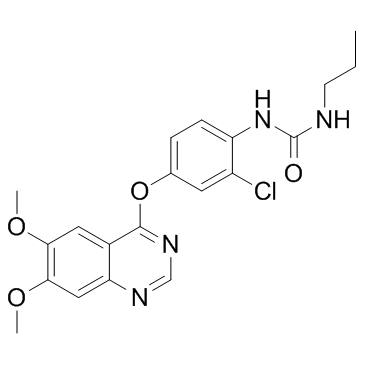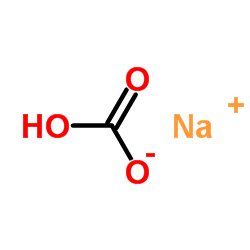KRN-633
Modify Date: 2025-08-25 06:52:14

KRN-633 structure
|
Common Name | KRN-633 | ||
|---|---|---|---|---|
| CAS Number | 286370-15-8 | Molecular Weight | 416.858 | |
| Density | 1.3±0.1 g/cm3 | Boiling Point | 545.6±50.0 °C at 760 mmHg | |
| Molecular Formula | C20H21ClN4O4 | Melting Point | 229 °C | |
| MSDS | Chinese USA | Flash Point | 283.7±30.1 °C | |
| Symbol |

GHS07 |
Signal Word | Warning | |
Use of KRN-633KRN-633 is a potent VEGFR inhibitor with IC50s of 170, 160 and 125 nM for VEGFR1, VEGFR2 and VEGFR3, respectively. |
| Name | 1-[2-chloro-4-(6,7-dimethoxyquinazolin-4-yl)oxyphenyl]-3-propylurea |
|---|---|
| Synonym | More Synonyms |
| Description | KRN-633 is a potent VEGFR inhibitor with IC50s of 170, 160 and 125 nM for VEGFR1, VEGFR2 and VEGFR3, respectively. |
|---|---|
| Related Catalog | |
| Target |
VEGFR1:170 nM (IC50) VEGFR2:160 nM (IC50) VEGFR3:125 nM (IC50) |
| In Vitro | KRN-633 inhibits tyrosine phosphorylation of VEGFR-1, VEGFR2, c-Kit, and PDGFR-β (IC50=11.7, 1.16, 8.01, 130 nM) in human umbilical vein endothelial cells. KRN-633 also inhibits the VEGF-driven proliferation of HUVECs (IC50=14.9 nM). KRN-633 suppresses capillary tube formation of endothelial cells[1]. |
| In Vivo | KRN-633 inhibits tumor growth in several tumor xenograft models with diverse tissue origins, including lung, colon, and prostate, in athymic mice and rats. KRN-633 also causes the regression of some well-established tumors and those that have regrown after the cessation of treatment. KRN-633 is well tolerated and has no significant effects on body weight or the general health of the animals. Histologic analysis of tumor xenografts treated with KRN-633 reveals a reduction in the number of endothelial cells in non-necrotic areas and a decrease in vascular permeability[1]. |
| Kinase Assay | Cell-free kinase assays are done to obtain IC50 values against a variety of recombinant receptor and non-RTKs. KRN-633 is tested from 0.3 nM to 10 μM. All assays are done in quadruplicate with 1 μM ATP[1]. |
| Cell Assay | A549, Ls174T, HT29, DU145, LNCap, and PC-3 cells cancer cells are cultured for 24 hours before adding KRN-633 (0.01 to 10 μM) or vehicle (0.1% DMSO in medium) and then grow for a further 96 hours. Cell viability is measured using WST-1 reagent. The percentage viability is determined relative to the untreated control[1]. |
| Animal Admin | Rats: Human tumor xenografts are established in the hind flank of athymic rats (BALB/cA, Jcl-nu). Rats are randomized into groups of five at the point when the tumors reach the average size indicated (162 to 657 mm3) and are then treated with KRN-633 or vehicle, either once (qd) or twice (bid) per day, at the dosages shown. The percentage of tumor growth inhibition compared with the vehicle-treated group is calculated on the day after the last treatment (day 14)[1]. Mice: The mice are randomized into groups of five at the point when the tumors reached the average sizes: 103 to 260 mm3 or 500 to 667 mm3. They are then treated with KRN-633 or vehicle, either once (qd) or twice (bid) per day, at the dosages of 10-100 mg/kg. The percentage of tumor growth inhibition (TGI) compared with the vehicle-treated group is calculated on the day after the last treatment[1]. |
| References |
| Density | 1.3±0.1 g/cm3 |
|---|---|
| Boiling Point | 545.6±50.0 °C at 760 mmHg |
| Melting Point | 229 °C |
| Molecular Formula | C20H21ClN4O4 |
| Molecular Weight | 416.858 |
| Flash Point | 283.7±30.1 °C |
| Exact Mass | 416.125122 |
| PSA | 98.09000 |
| LogP | 4.14 |
| Appearance of Characters | white to beige |
| Vapour Pressure | 0.0±1.5 mmHg at 25°C |
| Index of Refraction | 1.629 |
| InChIKey | VPBYZLCHOKSGRX-UHFFFAOYSA-N |
| SMILES | CCCNC(=O)Nc1ccc(Oc2ncnc3cc(OC)c(OC)cc23)cc1Cl |
| Storage condition | ?20°C |
| Water Solubility | DMSO: soluble3mg/mL, clear (warmed) |
|
~65% 
KRN-633 CAS#:286370-15-8 |
| Literature: EP1153920 A1, ; |
| Precursor 3 | |
|---|---|
| DownStream 0 | |
| N-{2-chloro-4-[(6,7-dimethoxy-4-quinazolinyl)oxy]phenyl}-N'-propylurea |
| N-(2-chloro-4-((6,7-dimethoxy-4-quinazolinyl)oxy)phenyl)-N'-propylurea |
| Urea, N-[2-chloro-4-[(6,7-dimethoxy-4-quinazolinyl)oxy]phenyl]-N'-propyl- |
| 1-(2-chloro-4-(6,7-dimethoxyquinazolin-4-yloxy)phenyl)-3-propylurea |
| 1-{2-chloro-4-[(6,7-dimethoxyquinazolin-4-yl)oxy]phenyl}-3-propylurea |
| KRN633,KRN-633,KRN 633 |
| S1557_Selleck |
| 1-{2-Chloro-4-[(6,7-dimethoxy-4-quinazolinyl)oxy]phenyl}-3-propylurea |
| KRN633 |
| VEGF Receptor Tyrosine Kinase Inhibitor III,KRN633 |
| KRN 633 |
| KRN-633 |
![2-Chloro-4-[(6,7-dimethoxy-4-quinazolinyl)-oxy]aniline structure](https://image.chemsrc.com/caspic/473/286371-63-9.png)

